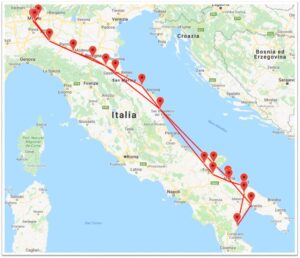The version 2.0 of the FP-ATR-SIGFOX1 Function Pack, recently available for download, brings the ability to use a Bluetooth Low Energy peer-to-peer connection to configure some of the behaviors of our Sigfox™ stack (X-CUBE-SFXS2LP1) and S2-LP sub-gigahertz module. We are also releasing a mobile application, ST Asset Tracking, for Android – an iOS version is on the way – so developers can quickly start testing this new feature with a smartphone before they work on their software. Additionally, a brand new web Dashboard facilitates the registration and management of devices. As a result, beyond offering libraries and tools to more easily create feature-rich applications, we are also providing graphical user interfaces and web utilities to more immediately see what our solutions can do.
All it takes is a NUCLEO-L053R8 or NUCLEO-L476RG to serve as a base, the X-NUCLEO-IKS01A2 sensor board as well as the X-NUCLEO-S2868A1 that integrates an S2-LP, and the X-NUCLEO-IDB05A1 Bluetooth module. The S2-LP is an ultra-low-power RF transceiver that can last up to 10 years on a single battery while the Bluetooth board uses a BlueNRG-MS single-mode Bluetooth 4.2 network processor that’s popular in embedded systems. The Function Pack contains a precompiled binary enabling teams to start tracking assets in minutes. Systems increasingly use the Sigfox network to connect non-powered assets to the cloud. We thus decided to offer the FP-ATR-SIGFOX1 Function Pack last November to facilitate the development of asset tracking (ATR) applications on the Sigfox network and we continue to update the software package with new features.
Building Asset Tracking Prototypes with ST Boards, FP-ATR-SIGFOX1, and the New Dashboard
The Function Pack rests on our STM32 Cube Expansion Package X-CUBE-SFXS2LP1, a middleware containing the Sigfox stack and the Hardware Abstraction Layer necessary to take advantage of the S2-LP transceiver. It also includes a quick start guide that shows how to register the S2-LP board onto the Sigfox back end by first getting the right credentials from our graphical user interface tools, then submitting them to Sigfox and associating them with the free account that users create on the operator’s website.
The presence of the web dashboard further simplifies these operations by offering a faster and easier way to deploy and test devices in the field. It allows devices to register to the Sigfox back end while also displaying the geographical location of all devices on a map at the same time. Developers can also enjoy a certain granularity with the ability to select a single system and check its geographical history over a time interval that users can define. The system can also output the data recorded by the sensor board to plot a chart and track specific values, which makes it easier to create applications that trigger a command after a particular event, such as a movement.
Bluetooth and Low Power Consumption, the Secret Weapons of the Function Pack
The Function Pack makes testing and prototyping easier, but adding a Bluetooth Low Energy component further increases its user-friendliness. Engineers can add the X-NUCLEO-IDB05A1 Bluetooth board to their stack and download the ST Asset Tracking mobile app to talk to the board and make it easier to track an asset. Developers can thus set specific parameters from the mobile application, instead of having to go through their integrated development environments or their serial terminal, which also makes testing certain aspects of the solution, such as its power management, a lot more straightforward.
The low power consumption of our solution is probably one of its most impressive and yet lesser-known features. The demo application includes low power profiles and smart mechanisms that put the module to sleep right after it sends a message to the Sigfox back end to maximize efficiency. Additionally, it is possible to program its behavior to wake the S2-LP up only after the sensors report a specific event, or after a delay. The Bluetooth module and mobile application will help developers test these features, and since the Function Pack includes our source code, they will also be able to integrate them in their application rapidly.
Traveling Across Italy with the FP-ATR-SIGFOX1

Gerardo Gallucci, in charge of Low-Power RF Product Marketing at ST, wanted to show the power behind our Function Pack by running a little experiment. He used a NUCLEO-L476RG with the sensor and S2-LP boards, and did nothing else but load the precompiled binary of the Function Pack before registering his device on the Sigfox back end. He then moved the jumper JP5 of the Nucleo board to the E5V side to be able to use a battery pack with his stack, then traveled from the north to the south of Italy and back, using the Sigfox module to track his approximate location every 15 minutes. At the end of his trip, Gerardo downloaded the information from Sigfox’s back end and plotted his coordinates on Google Maps, the picture on the right showing his trip.
The precision of the information depends on the Sigfox coverage but in 80% of cases, it is within a radius of fewer than ten kilometers (6.2 miles). Gerardo didn’t use a GPS module, so the system stored the coordinate of the Sigfox antenna and not the user’s geolocation. On average the stack running the Function Pack was within a two to 15 kilometers (1.2 miles to 9.3 miles) radius, but the low-power and ease-of-use of this system far outweighed the need for even higher precision. In the field, a tracking module could rely only on GPS when assets are on a boat, then turn on the less power hungry S2-LP board and upload its coordinate to the Sigfox cloud once the assets travel by land, thus optimizing power consumption without severe compromises to the users tracking a shipment.
- Download the FP-ATR-SIGFOX1 Function Pack
